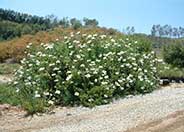
Common name:Matilija Poppy
Botanical name:Romneya coulteri
Crowned by white poppies, this high-impact, spreading, gray green perennial stands statuesque at 8' tall. It is best used where its scale and habit will not overpower neighboring plants. It requires no summer water and thrives on dry alluvial slopes.
Maintenance Tips
Romneya coulteri is a large, herbaceous, California native perennial that is grown for its attractive gray-green foliage and showy, white poppy flowers that bear resemblance to fried eggs. It can grow up to about 8' tall and wide but can spread up to 20’ away by underground runners known as rhizomes. Despite its large size, it is relatively easy to maintain. Flowering begins in the spring and lasts until late summer. In the fall, the foliage will start to wither, which is when it is best to cut all the stalks down to about 6". Once they are removed, you can leave this plant alone to regrow back in a matter of a couple of months.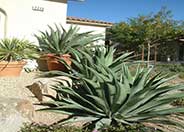
Common name:Smooth-edged Agave
Botanical name:Agave weberi
This is a striking medium-sized Agave that can grow to 5' tall by 6'-10' wide. This agave has very fine marginal teeth and is sometimes spineless. Supplemental summer watering can prevent yellowing from heat stress in the summer. These plants are also moderately cold hardy and tolerant of temperatures down to 12 degrees F. It is more refined looking than americana. It is native in central Eastern Mexico. It is one of the largest of the Agaves.

Common name:Sundrops
Botanical name:Calylophus hartwegii
This low-growing perennial grows 1' tall and 3' tall; it has woody stems with bright green leaves. It produces large, lemon yellow flowers that are up to 4" across and bloom spring through summer and possibly through fall, depending on weather conditions.
Maintenance Tips
Calylophus hartwegii is a soft-textured, low-growing perennial with bright yellow flowers. It only grows 12" tall and up to 3' wide. It is very fast growing in the late winter and early spring, and then it is covered with flowers from mid-spring until fall if the weather is ideal. In the fall, when the days start to get shorter and the rains begin, this plant can decline. The root system will stay intact, but the flowering stops, and the foliage will completely die back. This plant benefits from hard pruning, taking the foliage, and branching almost down to the ground. Don't expect any new growth to emerge until the days start to get longer and warm up. The foliage will start to emerge, and the plant's quick growth and blooming cycle will return.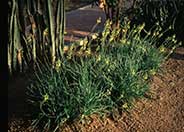
Common name:Yellow Stalked Bulbine
Botanical name:Bulbine frutescens
Bulbine frutescens is an evergreen perennial that grows 1.5' tall and wide. The leaves are narrow and long. This low-spreading plant is attractive year round.
Maintenance Tips
Bulbine frutescens is a grass-like succulent that has a very dense form that can grow 18" tall and wide. It can bloom throughout the year and is very attractive to hummingbirds, bees, and butterflies. To keep this plant low maintenance, plant it in full sun with excellent drainage. Rock gardens are a perfect location. The plant is drought tolerant once established but will require some supplemental soil as it is rooting. This plant can spread from underground roots, so it can be invasive if it is happy in the environment. There is very little maintenance required to keep it looking and performing its best, but it should be divided every couple of years to invigorate it. If the plant looks dull and discolored, there is a good chance it is going into its drought mode, so some supplemental water will kick start it again.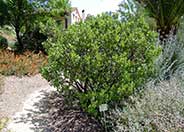
Common name:Manzanita, Dr. Hurd
Botanical name:Arctostaphylos manzanita 'Dr. Hurd'
This is a large shrub with showy bark that reaches 8'-20' tall and wide. It has dark red bark, large pale green leaves and white to pink flower clusters that bloom from February to March.

Common name:Purple Leaf Eastern Redbud
Botanical name:Cercis canadensis 'Forest Pansy'
This small tree may reach 25' tall and it has dark green/purple leaves that are purple in the fall. Amazing pink flowers bloom in the spring and fill the tree.
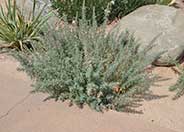
Common name:California Fuchsia, Zauschneria
Botanical name:Epilobium canum
The California fuchsia is a perennial with dense, narrow, green gray foliage and red orange summer flowers. The growth habit of this plant is sprawling and low. The California fuchsia is native to California, is drought tolerant, and attracts hummingbirds.
Designer: Susan Triindle
Photographer: GardenSoft